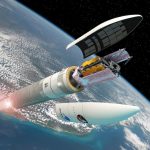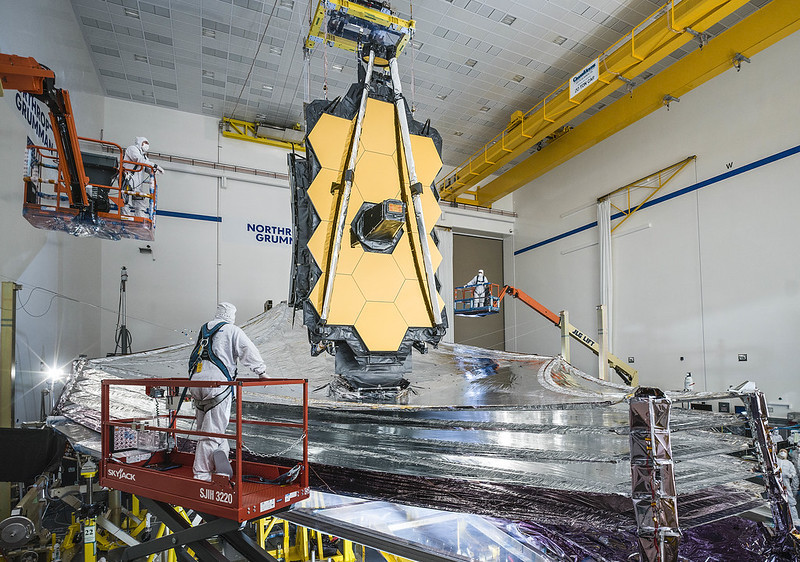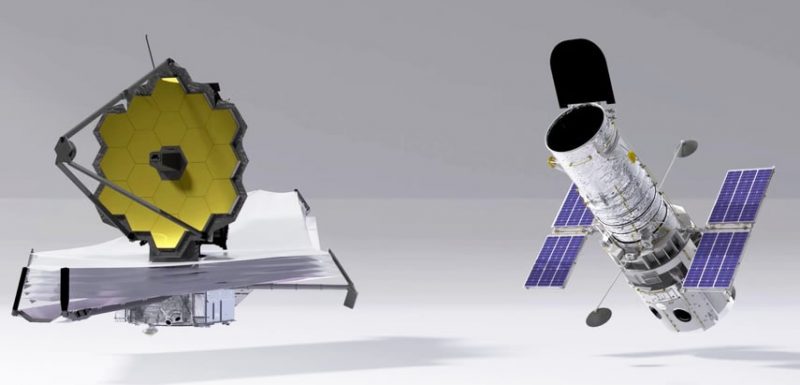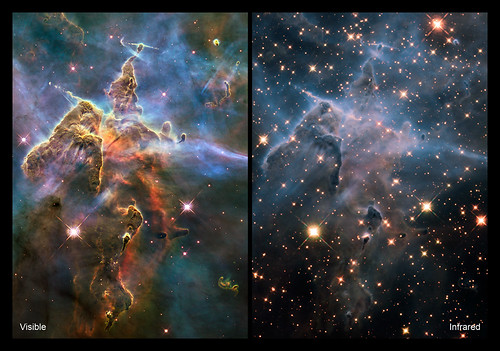

After having successfully deployed its solar panels – precisely as it’s supposed to do once it’s in space – the Webb telescope is shown here ready for the final tests on December 17, 2020, at NASA’s Goddard Space Flight Center. It will be packed up and transported to French Guiana to be launched on October 31, 2021, via an Ariane V rocket. Image via NASA/ Chris Gunn.
The James Webb Space Telescope – aka JWST or simply the Webb – will be the largest, most powerful and most complex infrared telescope ever built. Thousands of astronomers worldwide will use it for a wide range of research projects, complementing and extending the discoveries of the magnificent Hubble Space Telescope, as well as the now-decommissioned Spitzer infrared space telescope.
Once in space, above Earth’s obscuring atmosphere, the Webb will provide unobstructed views of the near and distant cosmos. Since light has a finite speed (186,000 miles per second, or 300 km per second), the new space telescope will also provide insights into our universe’s past: from the first light after the Big Bang, to the formation and evolution of galaxies, to our own and other planetary systems.
Thus the Webb will be used for study of every phase in the history of our universe.

Artist’s concept of the deployment of the James Webb Space Telescope from an Ariane 5 rocket. The launch is currently planned for October 31, 2021. Image via ESA.
The Webb telescope, formerly known as the Next Generation Space Telescope, was renamed in September 2002 after James Webb, who was an esteemed former NASA administrator. The entire project is an international collaboration between NASA, the European Space Agency, and the Canadian Space Agency. NASA’s Goddard Space Flight Center in Greenbelt, Maryland, manages the development effort, while Northrop Grumman in Redondo Beach, California, serves as the project’s main industrial partner.
As they did for the Hubble, the Space Telescope Science Institute in Baltimore, Maryland, will be operating the Webb telescope after launch.
One of the Webb’s most important and identifiable attributes is its golden 21-foot-wide (6.5-meter-wide) primary mirror. A reflecting telescope’s primary mirror determines how much light it can collect, and thus how deeply it can see into the universe. Webb’s mirror is nearly three times wider than Hubble’s primary mirror. It’s composed of 18 separate hexagonal-shaped segments made of ultra-lightweight beryllium, which will unfold after launch.
The Webb’s biggest feature, however, is its tennis court-sized sunshield, designed to reduce the sun’s heat by more than a million times, to -364 degrees F (-220 degrees C). The purpose of the sunshield is to keep the mirror and instrumentation cold. If it were to be heated up by the sun, it would give off its own infrared radiation and drown out the faint infrared signals from the distant galaxies it’s meant to measure.
The Webb is equipped with four cameras and spectrometers with detectors able to record extremely faint signals. One of these, the Near InfraRed Spectrograph has programmable “microshutters” that let it observe up to 100 objects at the same time. The detectors of one of the other instruments require even colder temperatures to function than the sunshield can provide, so a cryocooler keeps it at around -447 Fahrenheit (7 kelvin or -266 degrees C).

Artist’s concept of the overall size comparison of the Webb (left) and Hubble telescopes. Image via GSFC/ NASA.

Webb will have a 6.5-meter-diameter (21-foot-diameter) primary mirror. Hubble’s mirror is 2.4 meters in diameter (about 8 feet). Note the human figure for scale. Image via NASA.
The capabilites of the Webb extend beyond those of the Hubble Space Telescope and it is thus not a replacement but rather a successor (and the two telescopes will even collaborate side by side for a while, with a planned overlap). The Webb will observe further into the infrared regions of the electromagnetic spectrum and with greater sensitivity, allowing it to go even deeper than the Hubble, and to look further into the past and inside stellar dust clouds where stars and star systems form. Thaddeus Cesari, a communications specialist for the mission, wrote:
In addition to the groundbreaking science expected from it after launch, Webb has required an improvement in the testing infrastructure and processes involved in validating large complex spacecraft for a life in space … Lessons learned from previous space telescope development were invested into Webb, and future space telescopes will be built upon the same collective knowledge. Thousands of scientists, engineers, and technicians contributed to build, test, and integrate Webb. In total, 258 companies, agencies, and universities participated: 142 from the United States, 104 from 12 European nations, and 12 from Canada.

How we view objects in space depends in part upon which wavelengths of the electromagnetic spectrum are being received by the telescope. Here’s a comparison of the Carina Nebula in visible light (left) and infrared (right), both images by Hubble. In the infrared image, we can see more stars that weren’t visible before. Image via NASA/ ESA/ M. Livio & Hubble 20th Anniversary Team.
NASA is now targeting October 31, 2021, for the launch of the Webb telescope. The telescope will ride to orbit on an Ariane 5 rocket from the ELA-3 launch site at the European Spaceport located near Kourou, French Guiana.
Development began in 1996 for a launch that was initially planned for 2007 and a $500 million budget. But the project has had considerable delays and cost overruns, and underwent a major redesign in 2005. Afterwards, the launch was planned for March 2020, but the ongoing coronavirus pandemic also caused major setbacks.
Yet now, significant progress has been made, and existing program funding will have the Webb finished within its current $8.8 billion cost cap, NASA says.
In October 2020, the project successfully completed environmental testing trials designed to simulate the considerable rigors of launch. And in December 2020, the sunshield of a fully assembled James Webb Space Telescope successfully completed a final series tests, including a complete unfolding of the sunshield, just as the telescope will need to do once in space. Read more about the final sunshield tests in this NASA post.
But the Webb isn’t quite ready to ship to its launch site yet. As of February 2021, it has more tests to undergo, NASA officials said. Once it lifts off, the massive observatory will make its way to Lagrange Point 2, a gravitationally stable point 930,000 miles (1.5 million km) from our planet. The Webb will then deploy its sunshield and begin studying the cosmos in infrared light using its dazzling mirror. This is when the Space Telescope Science Institute will step in to operate. Thomas Zurbuchen, associate administrator for NASA’s Science Mission Directorate at the agency’s headquarters in Washington, said:
The perseverance and innovation of the entire Webb Telescope team has enabled us to work through challenging situations we could not have foreseen on our path to launch this unprecedented mission. Webb is the world’s most complex space observatory, and our top science priority, and we’ve worked hard to keep progress moving during the pandemic. The team continues to be focused on reaching milestones and arriving at the technical solutions that will see us through to this new launch date next year.
Twentytwo artists were selected nationwide to attend the James Webb Space Telescope Artist Event at NASA Goddard. They sat directly in front of the Webb telescope and were briefed on the mission by scientists, engineers and other project personnel while they worked; sketching, painting, writing, sewing, playing music. Visit this gallery to see their astonishing impressions of the Webb and its mission.

The Webb will orbit the sun about a million miles (1.5 million km) away from the Earth, at what is called the 2nd Lagrange point or L2. Note that this graphic is not to scale. Image via NASA.
Bottom line: The James Webb Space Telescope is the world’s largest, most powerful, and most complex infrared telescope, built for astrophysical studies of the most distant universe. NASA is now targeting October 31, 2021, for its launch on an Ariane 5 rocket from the ELA-3 launch site at the European Spaceport located near Kourou, French Guiana.
Read more from EarthSky: James Webb Space Telescope passes environmental testing
The 2021 lunar calendars are here. Order yours before they’re gone!
from EarthSky https://ift.tt/3sdANn7


After having successfully deployed its solar panels – precisely as it’s supposed to do once it’s in space – the Webb telescope is shown here ready for the final tests on December 17, 2020, at NASA’s Goddard Space Flight Center. It will be packed up and transported to French Guiana to be launched on October 31, 2021, via an Ariane V rocket. Image via NASA/ Chris Gunn.
The James Webb Space Telescope – aka JWST or simply the Webb – will be the largest, most powerful and most complex infrared telescope ever built. Thousands of astronomers worldwide will use it for a wide range of research projects, complementing and extending the discoveries of the magnificent Hubble Space Telescope, as well as the now-decommissioned Spitzer infrared space telescope.
Once in space, above Earth’s obscuring atmosphere, the Webb will provide unobstructed views of the near and distant cosmos. Since light has a finite speed (186,000 miles per second, or 300 km per second), the new space telescope will also provide insights into our universe’s past: from the first light after the Big Bang, to the formation and evolution of galaxies, to our own and other planetary systems.
Thus the Webb will be used for study of every phase in the history of our universe.

Artist’s concept of the deployment of the James Webb Space Telescope from an Ariane 5 rocket. The launch is currently planned for October 31, 2021. Image via ESA.
The Webb telescope, formerly known as the Next Generation Space Telescope, was renamed in September 2002 after James Webb, who was an esteemed former NASA administrator. The entire project is an international collaboration between NASA, the European Space Agency, and the Canadian Space Agency. NASA’s Goddard Space Flight Center in Greenbelt, Maryland, manages the development effort, while Northrop Grumman in Redondo Beach, California, serves as the project’s main industrial partner.
As they did for the Hubble, the Space Telescope Science Institute in Baltimore, Maryland, will be operating the Webb telescope after launch.
One of the Webb’s most important and identifiable attributes is its golden 21-foot-wide (6.5-meter-wide) primary mirror. A reflecting telescope’s primary mirror determines how much light it can collect, and thus how deeply it can see into the universe. Webb’s mirror is nearly three times wider than Hubble’s primary mirror. It’s composed of 18 separate hexagonal-shaped segments made of ultra-lightweight beryllium, which will unfold after launch.
The Webb’s biggest feature, however, is its tennis court-sized sunshield, designed to reduce the sun’s heat by more than a million times, to -364 degrees F (-220 degrees C). The purpose of the sunshield is to keep the mirror and instrumentation cold. If it were to be heated up by the sun, it would give off its own infrared radiation and drown out the faint infrared signals from the distant galaxies it’s meant to measure.
The Webb is equipped with four cameras and spectrometers with detectors able to record extremely faint signals. One of these, the Near InfraRed Spectrograph has programmable “microshutters” that let it observe up to 100 objects at the same time. The detectors of one of the other instruments require even colder temperatures to function than the sunshield can provide, so a cryocooler keeps it at around -447 Fahrenheit (7 kelvin or -266 degrees C).

Artist’s concept of the overall size comparison of the Webb (left) and Hubble telescopes. Image via GSFC/ NASA.

Webb will have a 6.5-meter-diameter (21-foot-diameter) primary mirror. Hubble’s mirror is 2.4 meters in diameter (about 8 feet). Note the human figure for scale. Image via NASA.
The capabilites of the Webb extend beyond those of the Hubble Space Telescope and it is thus not a replacement but rather a successor (and the two telescopes will even collaborate side by side for a while, with a planned overlap). The Webb will observe further into the infrared regions of the electromagnetic spectrum and with greater sensitivity, allowing it to go even deeper than the Hubble, and to look further into the past and inside stellar dust clouds where stars and star systems form. Thaddeus Cesari, a communications specialist for the mission, wrote:
In addition to the groundbreaking science expected from it after launch, Webb has required an improvement in the testing infrastructure and processes involved in validating large complex spacecraft for a life in space … Lessons learned from previous space telescope development were invested into Webb, and future space telescopes will be built upon the same collective knowledge. Thousands of scientists, engineers, and technicians contributed to build, test, and integrate Webb. In total, 258 companies, agencies, and universities participated: 142 from the United States, 104 from 12 European nations, and 12 from Canada.

How we view objects in space depends in part upon which wavelengths of the electromagnetic spectrum are being received by the telescope. Here’s a comparison of the Carina Nebula in visible light (left) and infrared (right), both images by Hubble. In the infrared image, we can see more stars that weren’t visible before. Image via NASA/ ESA/ M. Livio & Hubble 20th Anniversary Team.
NASA is now targeting October 31, 2021, for the launch of the Webb telescope. The telescope will ride to orbit on an Ariane 5 rocket from the ELA-3 launch site at the European Spaceport located near Kourou, French Guiana.
Development began in 1996 for a launch that was initially planned for 2007 and a $500 million budget. But the project has had considerable delays and cost overruns, and underwent a major redesign in 2005. Afterwards, the launch was planned for March 2020, but the ongoing coronavirus pandemic also caused major setbacks.
Yet now, significant progress has been made, and existing program funding will have the Webb finished within its current $8.8 billion cost cap, NASA says.
In October 2020, the project successfully completed environmental testing trials designed to simulate the considerable rigors of launch. And in December 2020, the sunshield of a fully assembled James Webb Space Telescope successfully completed a final series tests, including a complete unfolding of the sunshield, just as the telescope will need to do once in space. Read more about the final sunshield tests in this NASA post.
But the Webb isn’t quite ready to ship to its launch site yet. As of February 2021, it has more tests to undergo, NASA officials said. Once it lifts off, the massive observatory will make its way to Lagrange Point 2, a gravitationally stable point 930,000 miles (1.5 million km) from our planet. The Webb will then deploy its sunshield and begin studying the cosmos in infrared light using its dazzling mirror. This is when the Space Telescope Science Institute will step in to operate. Thomas Zurbuchen, associate administrator for NASA’s Science Mission Directorate at the agency’s headquarters in Washington, said:
The perseverance and innovation of the entire Webb Telescope team has enabled us to work through challenging situations we could not have foreseen on our path to launch this unprecedented mission. Webb is the world’s most complex space observatory, and our top science priority, and we’ve worked hard to keep progress moving during the pandemic. The team continues to be focused on reaching milestones and arriving at the technical solutions that will see us through to this new launch date next year.
Twentytwo artists were selected nationwide to attend the James Webb Space Telescope Artist Event at NASA Goddard. They sat directly in front of the Webb telescope and were briefed on the mission by scientists, engineers and other project personnel while they worked; sketching, painting, writing, sewing, playing music. Visit this gallery to see their astonishing impressions of the Webb and its mission.

The Webb will orbit the sun about a million miles (1.5 million km) away from the Earth, at what is called the 2nd Lagrange point or L2. Note that this graphic is not to scale. Image via NASA.
Bottom line: The James Webb Space Telescope is the world’s largest, most powerful, and most complex infrared telescope, built for astrophysical studies of the most distant universe. NASA is now targeting October 31, 2021, for its launch on an Ariane 5 rocket from the ELA-3 launch site at the European Spaceport located near Kourou, French Guiana.
Read more from EarthSky: James Webb Space Telescope passes environmental testing
The 2021 lunar calendars are here. Order yours before they’re gone!
from EarthSky https://ift.tt/3sdANn7

Aucun commentaire:
Enregistrer un commentaire